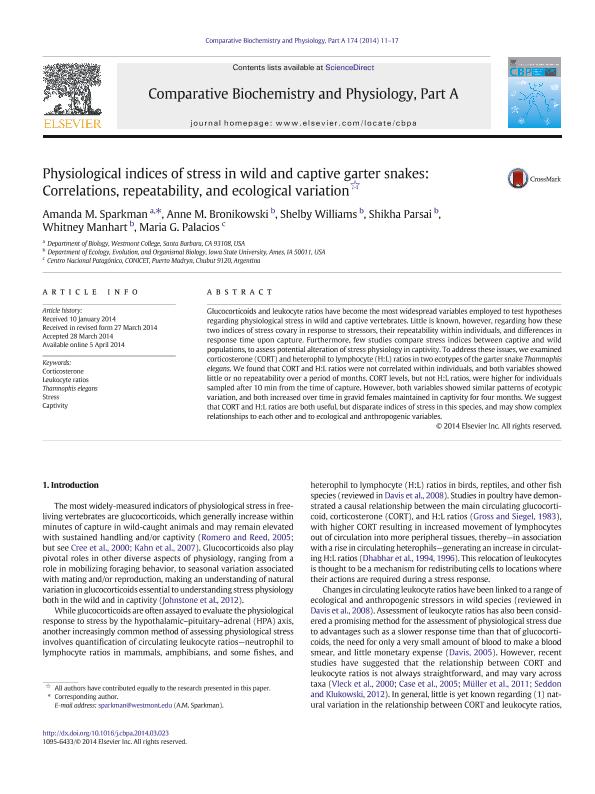Mostrar el registro sencillo del ítem
dc.contributor.author
Sparkman, Amanda M.
dc.contributor.author
Bronikowski, Anne M.
dc.contributor.author
Williams, Shelby
dc.contributor.author
Parsai, Shikha
dc.contributor.author
Manhart, Whitney
dc.contributor.author
Palacios, Maria Gabriela

dc.date.available
2017-06-29T19:33:13Z
dc.date.issued
2014
dc.identifier.citation
Sparkman, Amanda M.; Bronikowski, Anne M.; Williams, Shelby; Parsai, Shikha; Manhart, Whitney; et al.; Physiological indices of stress in wild and captive garter snakes: correlations, repeatability, and ecological variation; Elsevier; Comparative Biochemistry and Physiology Part A: Molecular and Integrative Physiology; 174; -1-2014; 11-17
dc.identifier.issn
0300-9629
dc.identifier.uri
http://hdl.handle.net/11336/19183
dc.description.abstract
Glucocorticoids and leukocyte ratios have become the most widespread variables employed to test hypotheses regarding physiological stress in wild and captive vertebrates. Little is known, however, regarding how these two indices of stress covary in response to stressors, their repeatability within individuals, and differences in response time upon capture. Furthermore, few studies compare stress indices between captive and wild populations, to assess potential alteration of stress physiology in captivity. To address these issues, we examined corticosterone (CORT) and heterophil to lymphocyte (H:L) ratios in two ecotypes of the garter snake Thamnophis elegans. We found that CORT and H:L ratios were not correlated within individuals, and both variables showed little or no repeatability over a period of months. CORT levels, but not H:L ratios, were higher for individuals sampled after 10 min from the time of capture. However, both variables showed similar patterns of ecotypic variation, and both increased over time in gravid females maintained in captivity for four months. We suggest that CORT and H:L ratios are both useful, but disparate indices of stress in this species, and may show complex relationships to each other and to ecological and anthropogenic variables.
dc.format
application/pdf
dc.language.iso
eng
dc.publisher
Elsevier

dc.rights
info:eu-repo/semantics/openAccess
dc.rights.uri
https://creativecommons.org/licenses/by-nc-sa/2.5/ar/
dc.subject
Corticosterone
dc.subject
Leukocyte Ratios
dc.subject
Thamnophis Elegans
dc.subject
Stress
dc.subject
Captivity
dc.subject.classification
Otros Tópicos Biológicos

dc.subject.classification
Ciencias Biológicas

dc.subject.classification
CIENCIAS NATURALES Y EXACTAS

dc.title
Physiological indices of stress in wild and captive garter snakes: correlations, repeatability, and ecological variation
dc.type
info:eu-repo/semantics/article
dc.type
info:ar-repo/semantics/artículo
dc.type
info:eu-repo/semantics/publishedVersion
dc.date.updated
2016-11-23T19:40:18Z
dc.journal.volume
174
dc.journal.pagination
11-17
dc.journal.pais
Países Bajos

dc.journal.ciudad
Amsterdam
dc.description.fil
Fil: Sparkman, Amanda M.. Westmont College; Estados Unidos
dc.description.fil
Fil: Bronikowski, Anne M.. Iowa State University; Estados Unidos
dc.description.fil
Fil: Williams, Shelby. Iowa State University; Estados Unidos
dc.description.fil
Fil: Parsai, Shikha. Iowa State University; Estados Unidos
dc.description.fil
Fil: Manhart, Whitney. Iowa State University; Estados Unidos
dc.description.fil
Fil: Palacios, Maria Gabriela. Consejo Nacional de Investigaciones Científicas y Técnicas. Centro Científico Tecnológico Conicet - Centro Nacional Patagónico; Argentina
dc.journal.title
Comparative Biochemistry and Physiology Part A: Molecular and Integrative Physiology

dc.relation.alternativeid
info:eu-repo/semantics/altIdentifier/url/http://www.sciencedirect.com/science/article/pii/S1095643314000725
dc.relation.alternativeid
info:eu-repo/semantics/altIdentifier/doi/http://dx.doi.org/10.1016/j.cbpa.2014.03.023
Archivos asociados
